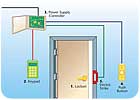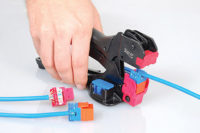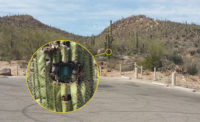
Although they are sometimes viewed as a commodity, keypads often are the end user’s primary — or only — interface with their access control system. Recognizing this, security dealers should take care to ask the right questions when selecting an access control keypad so that they make a choice with which their customers will be satisfied. Here are nine key questions to consider in the selection of an access control keypad.
1.SHOULD I USE A STAND-ALONE KEYPAD, A SELF-CONTAINED SYSTEM OR ONE THAT IS INTEGRATED WITH A COMPLETE ACCESS CONTROL SYSTEM?
The answer depends on the customer’s budget, the level of security required and whether or not the customer needs sophisticated features such as a large number of user codes.If the customer has or wants a complete access control system, which also may include card readers and other devices as well as a central controller, there are many advantages to using a keypad that can be tightly integrated with that system. With that approach, the keypad can be programmed from the central controller, enabling the system to easily support sophisticated functionality such as multiple users with different access privileges. Based on information collected at the keypad, the access control system also can be used to generate activity logs by user. Manufacturers typically have a limited list of compatible keypads, so be sure to ask which ones they support.
For customers who do not need a full-blown access control system, stand-alone keypads that are controlled from a remotely located control module also can provide a high level of flexibility in terms of user codes and other features. Some of these systems are programmed at the keypad, while others can be programmed through a computer that can be attached to the control module. “The best products for a small system allow the keypad control to operate off-line and only use a laptop with standard off-the-shelf or no-cost software for reporting functions when necessary,” advises Bryan Sanderford, national sales manager for access control manufacturer Dortronics of Sag Harbor, N.Y.
For customers with limited budgets and who do not require the highest level of security, a self-contained system — which is essentially a keypad with a built-in control module — is another option. The downside to these systems is that they typically must be programmed from the keypad, which can be cumbersome, they may not support an activity log and they may be limited to a single user code.
2.How many times will the keypad be used per day?
Based on your customer’s response, ask your vendor which keypad it recommends for that usage level. The cost of a keypad depends, to a large extent, on its durability. Lower-cost keypads tend to have lower-gauge membranes or plastic keys, while higher-cost keypads may have higher-gauge membranes or metal casings and keys, notes Todd Hammond, product marketing specialist for Canton, Mass.-based keypad manufacturer International Electronics Inc. (IEI). “A low-cost keypad would be OK if you’re going to use it 20 times a day,” Hammond advises.
This is a typical application for an access control keypad, in which the door is normally closed and mechanically locked. A valid keypad code or push button activates the electric strike to release the door.
3.IF THE KEYPAD WILL BE INSTALLED OUTDOORS, WHICH MODEL DOES THE VENDOR RECOMMEND, AND WHAT FEATURES MAKE THE DEVICE SUITABLE FOR OUTDOOR USE?
For exterior use, “a keypad should be totally sealed in order to protect the electronics from the elements such as rain, wind, etc.,” Sanderford says.Rich Hagala, customer support manager for manufacturer Securitron Magnalock Corp., Sparks, Nev., advises against using self-contained keypads outside for security reasons. “You don’t want the processor accessible from outside where people could pull the pad off to open the door,” he advises. “You should have a remote processor so that the keypad is no more than a dumb switch.”
4.IN AN AREA THAT MAY BE PRONE TO VANDALISM OR ABUSE, WHAT FEATURES ARE AVAILABLE TO PROVIDE EXTRA PROTECTION?
Keypads installed in schools and parking lots are prone to abuse and vandalism. One possible choice for such applications is a heavy-duty piezoelectric keypad, which has a metal front that is attached to a sensitive piezoelectric element that can detect finger touches, notes Fred Zimmerman, vice president for keypad manufacturer Essex Electronics of Carpinteria, Calif.Another possible approach is to use a power supply with a tamper loop so that if someone pries a keypad off the wall, he will not be able to get in, Hammond advises.
5. WHAT FORM FACTORS ARE AVAILABLE?
You may be able to save on installation time and create a better-looking installation if you take advantage of the different keypad form factors that are available. These include flush-mount keypads, keypads that install in single-gang boxes or mullion-mount keypads, which can fit on narrow vertical supports between two doors.6. DOES THE MANUFACTURER OFFER A KEYPAD WITH BACKLIT KEYS?
Backlit keys can be critical for low-light installations where the user would not otherwise be able to see the keys.7.WHAT CONDITIONS CAN THE KEYPAD REPORT?
In addition to opening a door, most keypads also have the ability to report special conditions, such as if a door is left open longer than a specified time period. “With access control, it’s very important to monitor the door position; it’s very important to know if a door didn’t close,” notes J.R. Hentschel, director of access control for Hingham, Mass.-based distributor Boyle & Chase Inc.8.HOW MANY RELAYS DOES THE PRODUCT OFFER?
A keypad’s flexibility and capabilities can be enhanced substantially with the judicious use of relays, which can be tailored to the needs of an individual installation. Hentschel points to the example of a two-door garage that would use different codes to control two different relays, each attached to a different door.George Cook, operations manager for keypad manufacturer Corby Industries of Allentown, Pa., offers another example of how a dealer might use a keypad with an extra relay. “You want a door that stays open 5 seconds when employees punch in their code,” Cook notes. “But you also may want the manager to be able to open the door and leave it unlocked.” That scenario can be achieved using a keypad with two relays, each controlled by a different code.
9.COULD A WIRELESS KEYPAD SOLVE MY INSTALLATION PROBLEM?
In certain situations, such as when installing a keypad to control a gate, it can be difficult to run a wire from the keypad to the gate. As an alternative, you may want to consider a keypad that handles that connection wirelessly.For gate applications, some customers also may appreciate – and be willing to pay for — the added level of convenience that comes from being able to gain entrance using a wireless keypad-style remote control.





